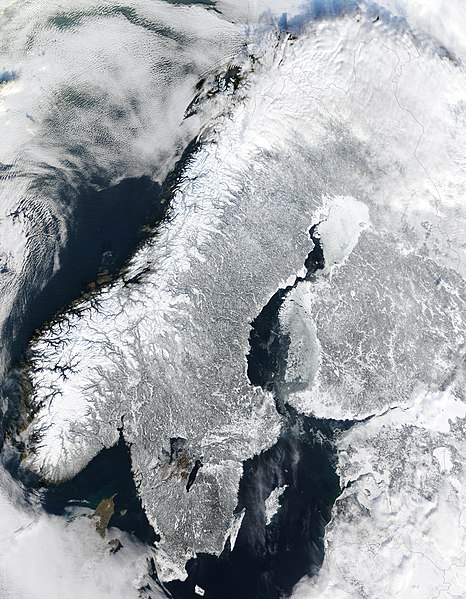| DescriptionScandinavia.TMO2003050.jpg |
English: Scandinavia from space in winter.
The Moderate Resolution Imaging Spectroradiometer (MODIS) instrument aboard NASA’s Terra satellite captured the above image of the Scandinavian Peninsula on February 19, 2003.
With a landscape largely shaped by glaciers over the last ice age, the Scandinavian Peninsula is as picturesque in the winter as it is cold. Along the left side of the peninsula, one can see the jagged inlets, known as fjords, lining Norway’s coast. Many of these fjords are well over 2,000 feet (610 meters) deep and were carved out by extremely heavy, thick glaciers that formed during the last ice age. The glaciers ran off the mountains and scoured troughs into Norway’s coastline with depths that reached well below sea level. When the glaciers melted, the seawater rushed into these deep troughs to form the fjords. The deepest fjord on Norway’s coast, known as Sogn Fjord, lies in southwest Norway and is 4,291 feet (1,308 m) deep.
Glaciers also carved the mountains in Norway and northernmost Sweden. South of this mountainous region, however, Sweden consists mostly of flat, heavily forested land dotted with lakes. Lake Vänern and Lake Vättern, the largest of Sweden’s lakes, do not freeze completely during the winter months and can be seen clearly at the bottom of the peninsula. Lake Vättern, the smaller of the two lakes, was connected to the Baltic Sea during the last ice age. After the ice melted, a tremendous weight was lifted off of the peninsula, and the landmass rose up to separate the lake from the Baltic Sea. To the northeast of the peninsula lies Finland with more than 55,000 lakes, most of which were also created by glacial deposits. Español: Escandinavia en invierno, imagen de la NASA Français : Scandinavie en hiver depuis l'espace. Image prise par l'instrument MODIS à bord du satellite Terra de la NASA.
Avec ses paysages sculptés par les glaciers du quaternaire, la Scandinavie en hiver est aussi pittoresque que froide. À l'ouest sont visibles les étroits bras de mer appelés fjords, qui ponctuent la côte norvégienne. Ces fjords très profonds (plus de 600 m et jusque 1 308 m dans le Sognefjord) ont été creusés par de lourds glaciers au cours des âges glaciaires. Ces glaciers descendus de la montagne ont creusé leurs vallées bien en dessous du niveau de la mer. À la fin de la glaciation, c'est donc la mer qui a envahi ces profondes vallées.
Au sud de ces montagnes, la Suède est un pays de plaines couvertes de forêts et de lacs. Les deux plus grands lacs de Suède, les lacs Vänern et Vättern, sont aisément visibles au sud car ils ne sont pas pris par les glaces en hiver. Le plus petit de ces deux lacs, le lac Vättern, était une baie de la mer baltique peu après la dernière glaciation. Après la fonte des glaces, et le retrait de leur poids énorme sur la péninsule, celle-ci s'est relevée et le lac a été séparé de la mer. Au nord est de la péninsule se trouve la Finlande, pays aux 55 000 lacs, souvent d'origine glaciaire. Nederlands: Satellietopname van Noorwegen, Zweden en Finland in de winter Română: Peninsula Sandinavă în timpul iernii — vedere din satelit (19 februarie 2003). Русский: Скандинавский полуостров зимой (19 февраля 2003) Svenska: Satellitbild över Skandinavien. I Norge finns det fjordar, i Sverige sjöar och i Finland också. Hela halvön är täckt av snö på vintern. Även om det är kallt om vintern nu, så var det ännu kallare på istiden. Deutsch: Skandinavien im Winter vom Weltraum aus.
Das Moderate-resolution Imaging Spectroradiometer (MODIS) des NASA Satelliten Terra nahm dieses Bild der Skandinavischen Halbinsel am 19. Februar 2003 auf.
Mit einer größtenteils in der letzten Eiszeit von Gletschern geformten Landschaft ist die Skandinavische Halbinsel im Winter so malerisch, wie es kalt ist.
Auf der westlichen Seite der Halbinsel kann man zerklüftete Buchten, die als Fjorde bezeichnet werden, sehen, welche Norwegens Küste säumen. Viele dieser Fjorde sind mehr als 600 Meter tief und wurden von sehr schweren, dicken Gletschern, die sich während der letzten Eiszeit gebildet hatten, geformt. Die Gletscher flossen die Berge hinab und gruben dabei Täler in Norwegens Küste, die bis weit unter die Meereshöhe reichen. Als die Gletscher schmolzen, floss das Meerwasser in die tiefen Täler hinein und bildete dadurch die Fjorde. Der tiefste Fjord der norwegischen Küste, der Sognefjord, liegt im Südwesten Norwegens und ist 1308 m tief.
Auch die Berge in Norwegen und im Norden Schwedens wurden durch Gletscher geformt. Im Süden dieser bergigen Region ist Schweden jedoch ein flaches, stark bewaldetes, mit Seen gesprenkeltes Land. Die beiden größten Seen Schwedens, Vänern und Vättern frieren im Winter nicht vollständig zu und lassen sich im Süden der Halbinsel gut erkennen. Vättern, der kleinere der beiden Seen, war während der letzten Eiszeit mit der Ostsee verbunden. Nachdem das Eis jedoch geschmolzen war, hob sich die Landmasse und trennte dabei den See von der Ostsee, da ein gigantisches Gewicht von der Halbinsel genommen worden war. Im Nordosten der Halbinsel liegt Finnland mit mehr als 55.000 Seen, von denen die meisten auch von Gletschern gebildet wurden. |








